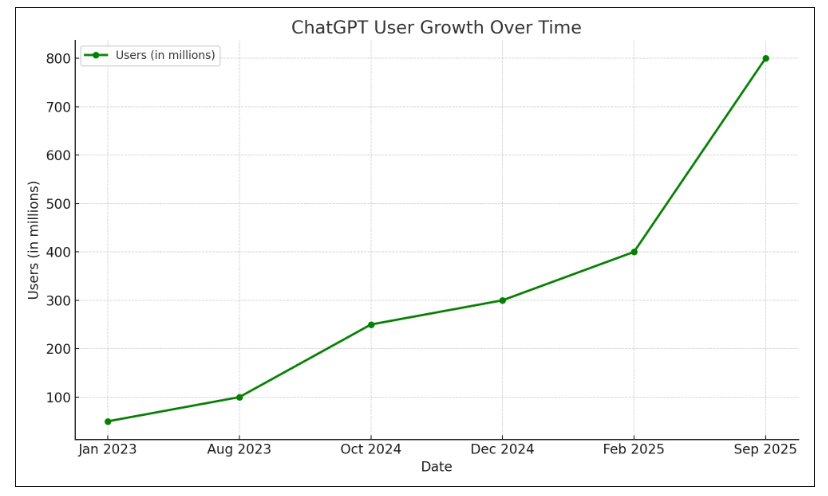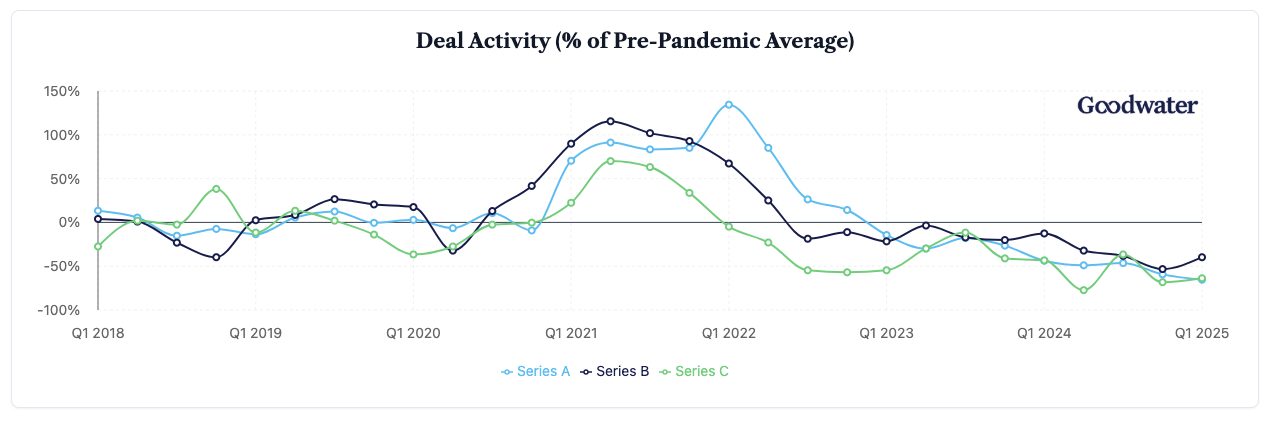
Sep 17, 2025
It’s Time For A B2C Comeback In the Age of AI. But it won’t be easy

Almost three years after ChatGPT’s launch, consumer adoption of AI is steeper than anything we’ve seen in past cycles.

Yet VC investment into consumer startups (excluding foundation models) hasn’t grown in recent years. And, the number of VCs with consumer experience or focus has also shrunk.


History as a predictor: the time is ripe for AI-native consumer companies
The emergence of the most successful consumer startups in prior platform shifts wasn’t immediate (we wrote about this, as geeks about the history of tech). B2C tech companies include AirBnB, Amazon, Google, Meta, and Uber, worth almost $7 TRILLION in aggregate today.
Web leaders like Netflix, Google and Reddit were founded two, three and ten years later respectively, after the Mosaic web browser launch in 1995.
The iPhone launched in 2007. It was years before leading mobile-native companies like Airbnb, Uber, WhatsApp, Snapchat, Discord and Doordash emerged.
Historically, the best consumer companies emerged 2-10 years after the ‘big bang’ of a platform shift. We're in that window now, almost three years post the ‘big bang’ of ChatGPT. The times are ripe for companies that leverage the inherent capabilities of LLMs and the incredible amount of compute and infrastructure now at our fingertips.
And yet, VC dollars in and consumer adoption of new AI apps (outside of ChatGPT, Claude etc) have lagged. Why?
Building a sustainably successful B2C company can be HARD.
There is an ICU (intensive care unit) and graveyard of struggling and failed B2C companies from the prior decades. Building a large, sustainably successful B2C co has different challenges than building for B2B. Some watchouts:
- The bar is high for scale, and capital efficiency. It likely takes $500m+ in revenue to go public nowadays. This makes a public ‘exit’ challenging. Meanwhile, leading B2C tech cos have gotten so large that a small acquisition often doesn’t move the needle; and multiples for smaller public B2C companies are lower, limiting what they can acquire. These trends have strained VC B2C funding - making addressable market size, story telling and unit economics and capital efficiency more important than ever.
- Pay attention to price points If low (like in the case of our portfolio co Dollar Shave Club, $8 for a set of razors), cost-effective customer acquisition and tight operations are of the utmost importance.
- Proprietary product, whether physical or digital, can deliver higher gross margins (like Warby Parker vs Chewy). Exclusive product and loyalty incentives (e.g. Sephora) can also lower the risk of switching; AI with memory and personalization should also help here.
- Be prepared for consumer tastes to change. Some may remember when everyone wore khakis to work (still love the OG Gap Khakis ad), or dressed like we were going on a safari (yes, really!) More recently, when dating apps, street scooter rentals and super soft workout wear were super hot…
- Transaction frequency, engagement, and customer lifetimes matter. There are limits to trips taken a year, or pairs of shoes one needs (in my case, i don’t need them, but…). It’s important to understand unit economics and measure conversion funnel, engagement time, frequency and LTV. Great products grow consumer frequency and spend over time (Instagram, Uber, Doordash, Amazon Prime are examples)
- Cracking CAC requires iteration, time and money. Paid channels require investment (e.g., ads, SEM, SEO, mail, events, influencers), and fluctuate in cost and effectiveness. Leading social media properties and influencers have the pricing power to make campaigns challenging for early stage startups. Referrals, virality (k-factor) and network effects can unleash fantastic low cost growth; but, success can be hard to manufacture, so planning iteration will help. Product worth talking about (Pinterest, Eight sleep, Oura, Strava…), plus creative execution (remember the Dollar Shave Club viral video?) can be key.
- Barriers to competition can be low. This makes exceptional execution in innovation, quality and velocity even more important.
Another watchout for B2C in the Age of AI: FRONTIER LABS
- Leading AI products like ChatGPT and Claude currently offer consumer utility for free. Consumers have free access to myriad time-saving solutions like “here’s a picture of what’s in my fridge, what should I make?”; “create a daily to-do list based on my inbox” and “plan and book 3 perfect days in New Orleans for a foodie.” This raises the bar for purpose-built B2C AI applications, especially for those who hope to charge transaction or subscription fees.
- Frontier labs have massive distribution, and aren’t sharing it with smaller companies. In prior platform shifts, startups acquired customers by figuring out how to leverage growing platforms like Google, Facebook or AppStore. LLMs offer incredible new capabilities for startups to leverage - but so far, no distribution other than “GEO”.
- OpenAI and Anthropic are recruiting world class app-building talent (like Fidji Simo and Statsig at OpenAI, Instagram’s Mike Krieger at Anthropic), signalling intent to “move up the stack” to applications. B2C AI founders’ best defense will be to build product using data the labs won’t have; or, to focus on a customer segment or need that benefits from a purpose-built UX and is not in frontier labs’ crosshairs.
But if history is an indicator, founders will find a way to build the future’s leading B2C companies. Areas where we see opportunity:
- Self-improving, personalized self-improvement. We’ve just scratched the surface on how AI will power products in all facets of health, wellness, and learning. We see big opportunities for self-improvement products that leverage individual data and feedback loops to adapt over time. For example- a future wellness product incorporates science-validated principles and guarantees privacy, accessing your personal data sources like your voice, sleep, health history, vital signs and what’s on your calendar - to recommend and act on on how you spend your time, what you eat, when you sleep and how to prep you for the upcoming week.
- AI-powered communication and self expression. Every decade or so, despite large incumbents, founders develop a big new advancement in communication or self-expression that sticks. Skype and WhatApp made previously expensive communications free over IP. Instagram inspired people to share, be entertained and follow with photos. Snapchat connected with filters and disappearing messages; Tiktok by making short form creation so easy, plus algorithmic recommendations. The time is ripe for new advancements - likely using AI to create, send, share or digest in even less time, or by designing new forms of creative delight.
- Reimagining the Productivity Stack with AI. The old paradigm of disconnected silos of info and workflows in email, calendar, contacts and notes will evolve massively. We see a re-imagining that leverages all your context - like a new email client that learns what to escalate, how to draft in your voice for work vs personal, and works behind the scenes knowing you’re in a meeting. Or a calendar that asks for your goals, gives quantified feedback on how you’re spending your time, suggests adjustments to help you meet your goals, and can take actions on your behalf.
These are just a few of the areas we’d love to meet founders building for consumers. Other considerations:
- Upgrade or re-imagine an existing consumer behavior with AI. Like Starbucks upgraded the $.99c commodity coffee experience, leading B2C companies took an existing consumer behavior (taking and sharing a photo, finding a place to stay, feeding your dog, getting therapy, learning a language) and made the behavior more accessible, delightful, or luxurious - utilizing the unique capabilities of new tech. The next generation of consumer AI-powered products should do the same.
- Build software that enables a better physical world experience. Many leading B2C companies leveraged the web or mobile to enable new, richer real world experiences. AirBnB, DoorDash, OpenTable, Pinterest, Reddit, Uber and Yelp are just a few examples.
- Tap into the 7 sins. Humans are often driven by ‘sins’ - vanity, greed, envy, gluttony, lust, wrath, sloth. List leading B2C products like Instagram, Coinbase, Strava, Doordash, Uber, Tiktok - you can easily match one or more ‘deadly sins’ with their appeal. It’s a useful filter when thinking about a product’s value prop.
- Use natural language input to learn, then personalize and evolve the user experience. Gone will be the days of having to click multiple screens at log in, or limited adaptations. Tomorrow’s successful B2C AI products will onboard customers via adaptive natural language (often, voice). Then, they’ll seamlessly and continually adjust the product experience, leveraging input in any language, plus context like social media posts, Spotify, Pinterest, and private data. They’ll use AI and memory to learn, anticipate and recommend what the customer might want.
- Hairy execution builds a great moat. Many leading B2C companies took on high risk, high reward operational and tech challenges, like building a 2 sided marketplace at AirBnB, DoorDash, Lyft and Uber. Getting massive amounts of hotel inventory at Expedia. Figuring out global music streaming rights at Spotify. Or building novel creation tools and algorithmic recommendations at Tiktok. Solving hairy challenges can create great defensibility - and add giant bonus points for product network effects.
We’re ALSO excited to meet founders who imagine B2C experiences we can’t predict. Who would have guessed a company that started by renting out someone’s couch would grow to serve over 1.5 billion global guest experiences? Or a black car rental service would evolve to ride sharing, food delivery and freight, coordinating 26m trips a day?
Many of the most successful founders re-imagined consumer experiences in ways we couldn’t have dreamed.
Despite new challenges in the AI platform shift, it’s time for a B2C comeback. Consumers are a massive market - spending over $16T per year in the US alone. We hope this post gives founders hoping to build new B2C experiences some inspiration, and useful watchouts.
And if you’re building something that will has the potential to be exceptionally delightful, cost effective and valuable for consumers - hit us up at hello@cowboy.vc or aileen@cowboy.vc, we’d love to meet you.
—---------------
Additional reading/thinking on building in B2C by consumer savvy VC friends we admire:
- Winning With Consumers in AI by Kirsten Green, Forerunner Ventures.
- After Hours: In Search of Native Business Models by Rebecca Kaden, Union Square Ventures
- 2025: The State of Consumer AI by Shawn Carolan, Amy Wu Martin, C.C. Gong, Sam Borja, Menlo Ventures
- WIll AI be as big of a catalyst for a consumer AI wave as mobile? by Sarah Tavel, Benchmark
- The Great Expansion: A New Era of Consumer Software by Olivia Moore, A16Z
- The Consumer AI revolution won’t be technical, it’ll be emotional by Sophie Bakalar, Collab Fund
- In Consumer AI, Momentum is Moat by Bryan Kim, A16Z
- Maveron’s 2025 predictions by Team Maveron
Heading 1
Heading 2
Heading 3
Heading 4
Heading 5
Heading 6
Lorem ipsum dolor sit amet, consectetur adipiscing elit, sed do eiusmod tempor incididunt ut labore et dolore magna aliqua. Ut enim ad minim veniam, quis nostrud exercitation ullamco laboris nisi ut aliquip ex ea commodo consequat. Duis aute irure dolor in reprehenderit in voluptate velit esse cillum dolore eu fugiat nulla pariatur.
Block quote
Ordered list
- Item 1
- Item 2
- Item 3
Unordered list
- Item A
- Item B
- Item C
Bold text
Emphasis
Superscript
Subscrinolkm;pvdidunt ut labore et dolore magna aliqua. Ut enim ad minim veniam, quis nostrud exercitation ullamco laboris nisi ut aliquip ex ea commodo consequat. Duis aute irure dolor in represdasc






